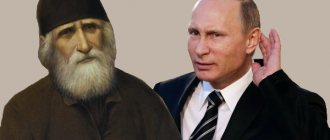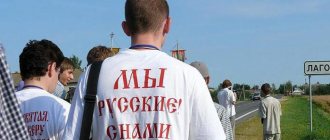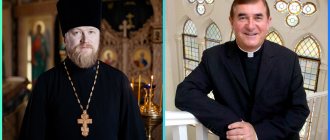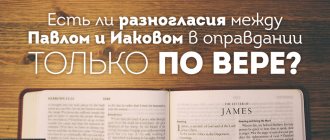[edit] Russian media
[edit] Intercession light of Orthodoxy | newspaper | since 2008 | 16-page publication of the Absheron deanery Ekaterinodar and Kuban diocese |
| Alpha and Omega | magazine | since 1994 | cultural and educational magazine dedicated to theological issues of Orthodoxy |
| Good | radio station | since 2000 | |
| Holy Fire | magazine, then website | since 1998 | a magazine dedicated to problematic issues of Orthodoxy |
| Living water | magazine and website | 2007 | published by the St. Petersburg Metropolitanate |
| Meeting | active | 1996 | student Orthodox magazine published by the Moscow Theological Academy |
| Journal of the Moscow Patriarchate | magazine | 1931-1935, from 1943 | official publication of the Moscow Patriarchate |
| Irkutsk Kremlin | almanac | since 2007 | Evgeniy Startsev |
| Channel of the Russian Orthodox Church on Youtube | Internet resource | since 2010 | official channel of the Russian Orthodox Church on Youtube |
| Cephas | newspaper | since 2002 | printed organ of the community headed by Archpriest Georgy Kochetkov |
| Mospat.Ru | Internet portal | 1997 | official website of the DECR, until 2009 - official website of the Russian Orthodox Church |
| Heir | magazine | since 2005 | magazine for Orthodox youth. Published by Archpriest Maxim Pervozvansky |
| Patriarchia.ru | Internet portal | since 2006 | official website of the Russian Orthodox Church, until 2009 - website of the press service of the Moscow Patriarchate |
| Orthodoxy and peace | Internet portal | since 2004 | the largest publication in the Russian Federation about Orthodoxy and the life of society. |
| Orthodox newspaper | newspaper | since 1994 | |
| Orthodox Radio of St. Petersburg | radio | since 1997 | |
| Orthodox word | newspaper | since 1991 | published by the Volgograd diocese |
| City of Petrov | radio | since 2000 | Archpriest Alexander Stepanov |
| Radio Image | radio | since 2007 | broadcasts with the support of the Nizhny Novgorod diocese |
| Radonezh | radio and newspaper | since 1991 | Evgeniy Konstantinovich Nikiforov |
| My joy | TV channel | since 2008 | Shramenko Marina Yurievna |
| Russian house | magazine | since 1997 | Alexander Nikolaevich Krutov |
| Russian shepherd | online publication, formerly a magazine | 1988 - 2003, since 2013 | originally published at Holy Trinity Theological Seminary in Jordanville |
| Meeting | magazine | since 2002 | Archpriest Sergius Titov |
| Union | TV channel | 2005 | created and broadcasts with the support of the Ekaterinburg diocese |
| Saved | TV channel | 2005 | |
| Tatyana's Day | online publication, formerly a newspaper | since 1995, website since 2006 | youth online magazine of Moscow State University |
| Thomas | magazine | since 1995 | magazine for the Orthodox intelligentsia |
| Christian reading | magazine | 1821—1917, since 1991 | Orthodox scientific and theological journal of the St. Petersburg Theological Academy |
| Church newsletter | newspaper | 1989 — 2012 | |
| Bread of Life (jhleb.ru) | magazine | since 2015 | a modern publication about the beauty of Orthodoxy. Published with the blessing of Metropolitan Ferapont of Kostroma and Nerekhta. |
| Vera 21 (vera21.ru) | online edition | since 2019 | publication on Orthodoxy in the twenty-first century |
| Name | view | years of publication | key figures |
| Veche | samizdat almanac | 1971 — 1974 | Vladimir Nikolaevich Osipov |
| Soulful reading | magazine | 1860 to 1917 | |
| Russian pilgrim | magazine | 1885-1917, 1990 — ? |
Between mission and media: Orthodox media in Russia
We are publishing a summary of the regular Tuesday “Open Seminar” of Polit.ru and the Institute of National Economic Model, created to discuss the position of our expert circle and community.
The topic of the seminar this time was the question of Russian Orthodox journalism, its main problems and place in the media system. The discussion centered on messages from the editor-in-chief of the Neskuchny Sad magazine, Yulia Danilova, and the editor-in-chief of the Foma magazine, Vladimir Legoyda. Participants in the discussion (except for Polit.ru itself) are Vitaly Naishul, Olga Gurova, Alexey Peskov, Mikhail Arsenin, Tatyana Malkina, Grigory Glazkov, Oleg Mudrak, Konstantin Sutyagin. Beginning
Until the mid-1990s. In fact, there was no system of Orthodox media in Russia. There was the magazine of the Moscow Patriarchate and the newspaper “Moscow Church Bulletin”, there were post-dissident and emigrant publications, there were experiments by nascent business corporations in the field of PR through short-lived Orthodox media projects.
In the mid-1990s. Sergei Chapnin organized the Orthodox information agency Metafrasis. It was a breakthrough. At the same time, the first publications were born, which have survived to this day. There were four main publications: the newspaper “Tatyana’s Day”, published at the Moscow State University temple, the magazine “Foma” (published since 1996), around the same time the magazine “Vstrecha” appeared, published by students of the Moscow Theological Seminary, and the theological and cultural almanac "Alpha and Omega", which appeared a little earlier.
Everything was new, there was no one to “do life.” Having appeared first, these publications set the model for the possible existence of Orthodox media in Russia. Turning to Catholic and Protestant journalism, publishers understood that, due to the specific cultural and historical situation of post-Soviet Russia, there was no experience that could be adopted. The emigrant Orthodox media also could not help (although the magazine “We” has recently followed in their footsteps).
None of the first Orthodox projects began as a business project. The magazine "Foma" appeared as samizdat. Its creators did not even think in professional terms. As its editor, Vladimir Legoida, said, “We just wanted to share our joy.” However, at some point it became clear that it was necessary to either close down or move to a professional level. There are inexorable laws of the market. For example, it is very difficult for a magazine that is published less than once a month to exist - people no longer remember it.
All of the listed publications were different from each other, but they all saw the problem of language as their main problem. After initial unsuccessful attempts to “work in the old fashioned way,” Orthodox journalism began to align itself with professional standards. Gradually they stopped speaking in pompous, moralizing language. We moved away from quoting the holy fathers on every occasion and using the Old Church Slavonic font. Texts have become more readable. Secular media, sensing this shift, began to attract representatives of Orthodox publications as experts on issues related to their sphere of competence, and this cooperation turned out to be quite fruitful.
Today
Over the past five years, Orthodox journalism has seen rapid growth. New publications are being born. In 2001 there were much fewer magazines than now. In 2005, there were about 800 registered Orthodox publications out of about 18,000 publications in total.
Modern magazines are very different, but they all gravitate towards large-format illustrated publications. The magazine “Grapes” appeared with a circulation of 7,000 copies; over the last two years, the magazine “Heir” has been successfully developing with a large circulation of 10,000. New publications have also appeared that can be called “niche”. This is the women's magazine "Slavyanka" with a circulation of 20,000. There is a children's magazine "Ladybug". This project is unique in its own way, since it has so far managed to stay on the market (predecessors similar to it disappeared very quickly). There is a magazine called Noah's Ark, which positions itself as missionary. In addition, a network of Orthodox Internet sites has developed that respond very quickly to news topics.
At the same time, it should be noted that most of the Orthodox media have remained within the framework of the formats proposed by the founders in the mid-nineties. The ones that stand out from the crowd are “Neskuchny Sad”, which managed to expand its format, and “Vinograd”, which is unlike anything else, but the rest follow a more or less beaten path. Magazines vary in the degree to which their audiences are “churched.” For example, “Neskuchny Sad” is addressed to a probably more church-going audience than the “Foma” magazine.
In general, today we can distinguish four types of publications: diocesan, “niche”, cultural and educational and conceptually Orthodox publications. The latter are magazines that do not claim to be Orthodox, but are created by Orthodox people within the framework of their ideas about what should be done. So far there are almost none, but it is this last direction that is perhaps the most promising.
Mission
If the task of traditional secular media is to inform, analyze, form public opinion, entertain, etc., then all current Orthodox publications recognize themselves as missionary publications. For secular media, food is news that occurs against the background of everyday routine, while for Orthodox magazines, food is all Orthodox topics. The tradition has been interrupted, and all issues, from the smallest to the institutional, are, in a sense, news.
Church media essentially writes about how to build a Christian life at the level of daily routine. All media formulate this task in their own way, but this task is still set. This is a kind of preaching through journalism. Each Orthodox publication has to decide what means to use and which of them are acceptable. One of the standard moves is an attempt to talk about Orthodox life through the appeals of people already known to the reader in some other form. Another way is to show pockets of activity: active people. Each of these paths has its own difficulties.
The editors of “Thomas” believe that the main criterion of an Orthodox magazine is “Christ’s Neskuchny Garden”; it adds a more practical orientation to the missionary orientation, as directly indicated by its subtitle “Orthodox magazine about works of mercy.” He is trying to act as a collective organizer of charitable activities, using, among other things, Internet resources. The magazine does not just invite people into the fold of the church. He calls them to specific deeds. For example, there is a website “Miloserdie.ru”, completely dedicated to charity; it directly connects people who need help with those who can provide it. A whole community of volunteers has already gathered around the site.
Between customer and consumer
The editors of Thomas thought for a long time about whether it was worth writing about it as an Orthodox magazine or whether it was worth, for example, simply indicating that it is a magazine that gives meaning to life, etc. They chose “Orthodox,” which imposes certain restrictions. Including the potential audience. One of the possible readers, belonging to the Armenian Apostolic Church, directly said that the first thing that makes it difficult to perceive the magazine is the word “Orthodox”, because it immediately takes him out of the circle of readers.
Another problem that secular publications either do not have or is not present in this form is relations with the official church. Having declared that the magazine is Orthodox, the publishers must navigate their ship between the Scylla of close church criticism and the Charybdis of reader taste. If this balance cannot be maintained, then the journal has no future. And the task of editorial policy is to find this balance.
Interaction with the church inevitably gives rise to certain “censorship” restrictions. Actually, any magazine has internal censorship, but in Orthodox media it has its own specifics. In the editorial office of Neskuchny Sad, ideas that arise in the editorial office at the stage of planning the issue are discussed in the format of a general discussion. They are then discussed with Fr. Arkady Shatov, who acts as a kind of confessor to the magazine. They subsequently read all publications. If something seems theologically unacceptable, it is removed.
In "Thomas" a somewhat more complex scheme is adopted. The spiritual director of the publication is more likely to be the confessor of the core of the editorial staff than the person who looks at the publication, perhaps because he appeared later than the magazine began to be published. At some point, a feeling arose in the editorial office that it was very bad when there was no confessor in the editorial office. And it arose naturally. This is a person who performs the “function” of inspiration. The presence of a confessor for a publication does not remove the issue of expert assessment. The magazine has an agreement with specialists from the St. Tikhon’s Institute, who are shown all the theological texts in the editorial portfolio. Reaction from experts comes in different forms. They may object on principle, or simply give advice. In this case, much depends on the author of the material itself. If this is an experienced priest-theologian, then, of course, the form of advice cannot be too harsh.
Magazine editors rarely have the opportunity to gain sociological insight into their audiences. Usually, based on general ideas, it is assumed that the main target group is people with at least a higher education and over 25 years of age. These are readers who have entered the age of social activity. These are young families who take an active position when it comes to building their lives.
If “Neskuchny Sad” is just about to take a closer look at its audience, then the editors of “Foma” have already managed to conduct their own research. They surveyed all editorial subscribers (several thousand people). About five hundred responded. The result was a picture that approximately coincided with expectations. Among the respondents, the following ratios were observed. Gender composition: 36% men, 64% women. Age: under 30 years old - 28%, 31-40 - 32%, 41-50 - 21%. Education: higher education - 73%, incomplete higher education - 7%, secondary education - 9%, academic degree - 5%. Economic education - 19%, technical - 18%, pedagogical - 13%, theological - 5.5%, etc. Social status: management - 20%, civil servants - 18%, science, culture, medicine - 15%, housewives - 13%, pensioners - 11%, 10% consider themselves managers.
The dispersion in both age and profession is very large. The gender structure is also relatively balanced. “Niche” highly specialized magazines, for example, “Slavyanka”, created specifically for Orthodox women, cannot boast of this. The situation is different at Neskuchny Sad and Foma. They try to touch on issues that may concern a person at any age. At the same time, it seems that niche Orthodox magazines have no future. Secular niche magazines rely on advertising tailored to specific target audiences. Since advertising in an Orthodox magazine seems something alien and unthinkable, the prospects for niche magazines look extremely doubtful.
In addition to the questionnaire survey, which allowed us to sketch a kind of social portrait of the reader, the editors communicate with the reader through other channels, trying to find out meaningful wishes. All communication opportunities during personal meetings are used, letters are being analyzed. There is a hotline. Every week the manager sends the chief editor a list of calls. Analysis of this information allows you to catch some trends. It is necessary to understand how much the declared central characteristic of “Christian Orthodox gloss” worries publishers. And you have to listen to them addressed to you quite often. Particularly because famous faces are often on the covers. But the cover serves an important function. In the beginning, the editorial office strictly observed the taboo on faces. It was believed that there should not be any faces on the cover. Over the years, publishers tried almost everything - flowers, elephants, cameras, but nothing good came of it and they had to return to faces. A “common man”, passing by a kiosk, does not specifically look for the same “Thomas”. He will only pick up a magazine if something interests him. Therefore, the face of a famous person should be there.
Due to double restrictions - on the part of the main “ideological customer” and on the part of the not fully clarified image of the intended reader, the presentation of many topics turns out to be associated with insurmountable difficulties. For the magazine “Thomas,” for example, communion and the schism of the Christian church became very difficult topics. All attempts to write about the history of the schism led to the creation of texts of a rather anti-missionary nature. Moreover, the problem was not that it was impossible to write an interesting and historically literate text about the divergence of confessions (after all, the history of the church is accessible to secular historians). But the editors do not set themselves the task of simply publishing an article written in good language. There is a strict internal criterion: “What does this give to Thomas?” The intended reader is Thomas, a believer, but doubting and strengthened in his faith only by personal experience. If the editor believes that the text does not give anything to Foma, then the text does not work. And all attempts to write about the split for Foma ended, from the point of view of the magazine’s editor-in-chief, in failure. It just doesn't work. From all that is brought to the editorial office on this topic, the average secular reader will make only one conclusion: “I thought so. For them, everything revolves around politics and human ambitions.”
At the same time, it cannot be said that pressure from the audience strictly determines the content of the magazine. There are, of course, quite obvious predictions. For example, it is known that the appearance of a large number of advertising pages will irritate the reader. However, the editors hope that they can afford to write and do what is interesting to the team of authors and at the same time be interesting to the reader.
Commercial component
There are three main models of media existence. Through sales, advertising and targeted funding, “which lights up this star because someone needs it.” Orthodox media is basically the third option. The magazine must have “friends” who believe that such a magazine simply should exist. The costs are generally very high: rent, fees, etc. In any case, they significantly exceed the amounts that can be obtained from the sale. This creates a certain tension in the financial situation. As a rule, a journal does not have one source of funding. There are a number of small donors, grants, and indirect sponsors.
Sponsors, businessmen themselves, are able to help not only with money. They can give advice on pricing policy and provide valuable organizational assistance in promoting the magazine to readers. For example, one day one of the magazine’s friends, inquiring about how the magazine was doing, advised almost doubling the price at which “Foma” goes to wholesale buyers. The editor-in-chief tried to prove that raising the price would lead to the disappearance of the magazine. However, the sponsors insisted. Prices have risen, but, amazingly, sales have also increased along with them. Another example: one of the friends of Foma magazine is the owner of a recruitment agency, he has about 650 regular clients. This year, at his own expense, he signed them all to Foma. The only thing left to do now is to call them in September to ask if they are receiving the magazine, and in December a second time to ask if they will renew their subscription. According to his forecasts, this action could result in 60 additional subscriptions. This is quite a bold move, and also requires certain resources. A move in normal marketing logic, but which simply did not occur to publishers focused on their subject. Sponsors of such publications usually do not try to influence the content of the magazine, and if they do, it is usually quite easy for them to refuse.
Some part of the money invested in such magazines is returned (about a third). More than three-quarters of the magazines are sold (about a sixth of which are by subscription), the rest is distributed as charity. The main distribution channels are the same as those of secular magazines. They are sold in kiosks at churches, at metro stations, in ordinary kiosks, some are distributed by subscription, some are sent through the church network to the provinces. Part of the subscription is corporate, sometimes entire organizations subscribe. Some sign entire organizations.
Sometimes, however, due to the specifics of the magazine's distribution environment, interesting incidents happen. When in 1995, representatives of the editorial office of one of the magazines came to the church to collect money from the sale of the magazine, they were told that the proceeds were donated to the restoration of the iconostasis.
https://www.polit.ru/author/2007/10/12/pravoslavniesmi.html
[edit] Near abroad
former
| type of media | years of publication | a brief description of | |
| Transfiguration (pravzhurnal.ru) | Internet magazine | since 2012 | an educational publication that helps in understanding the Orthodox doctrine of God, the Church, God's Love for us with the help of the works of the holy fathers and modern shepherds, to answer important questions of spiritual life; materials from the magazine's readers are also published |
| KRT | TV channel | since 2003 | initially positioned himself as Orthodox, then switched to entertainment broadcasting |
| Mgar Bell | magazine | 2002-2013 | "All-Ukrainian missionary and educational magazine" |
| Resources: 44 466 Entries from 1st: | CHOOSE YOUR STYLE: classic fresh original light | ||
| NEWS: | |||
| Catalog |
| home |
| SPEAKERS |
| News |
| ETHERS |
| Websites |
| Web interview |
| Calendar |
| Prayer |
| Music |
| Internet TV |
| Online Radio |
| ads |
| Communication |
| Acquaintance |
| Forum |
| Vote |
| Library |
| Articles |
| Ideas |
| Humor |
| About Us |
| Contacts |
| Support |
Total found: 4297
[ 1 — 20 ]
Living help is a mission that goes where the Lord Jesus sends it to preach the Gospel. Our goal is to convey the word of God to those who do not know about the good news. Along with this, we support missionaries, the poor, the needy, orphans, widows, lepers, the homeless and those rejected by modern society. working with prisons https://life-helps.org
passed: 104
Welcome to our home, to our family, to our church! We, “Living Water”, want to become a home and family for everyone who comes to us; for everyone who realizes that they need love and agrees to accept the help of Jesus Christ; for everyone who decides to live the life of a winner in the family of the Living God! You can visit our services in Hannover, Braunschweig and Hamelin and be convinced of God's mercy and Love in your life! https://www.lw-gemeinde.de
passed: 55
The goal of the largest Christian broadcasting organization, Transworld Radio (TMR), is to tell people about the hope in Jesus Christ. Motto. These words also define the purpose of our ministry in Belarus. There are currently seven radio programs on the air that are being prepared by the mission: “Voice of a Friend”, “Quiet Waters”, “Sulamite”, “Bread of Life”, “Word for Today”, “Grain”, “Bible Seekers”. https://twr.fm
passed: 38
My husband and I met on a Christian website. I am from Asia and my husband is from America, and because of this we opened a new Christian international dating site. The site will be in English. and in Russian languages. We will advertise our site all over the world and in the future there will be people here from all over the world. We invite all Christians who want to meet their soulmate or just find friends! Blessings to you in your quest! https://www.international-christians.com/?language=russian
passed: 36
New modern mobile-friendly website for Christian dating. https://meetingofsaints.com/
passed: 36
Website about amazing animals created by God https://zveri911.ru
passed: 35
Official website of the Christian Church “House of Glory of God”. History of the church, life of the church, video sermons and more. TV show “Exit”. https://dimslavy.com/
passed: 32
The only dating service on the RuNet for marriage and serious relationships, based on Christian principles. A perfect system for searching for potential partners, selection of denominations and religions, search by region and country, trilingual interface. https://adam-i-eva.com/
passed: 32
The publishing house "KNIGONOSHA"™ is the new name and legal successor of the publishing house of the Christian Biblical Brotherhood of St. Apostle Paul. https://knigonosha.com
passed: 32
Official website of writer Marie Sawyer. Author of adventure novels in the fantasy genre https://www.mari-sawyer.ru
passed: 31
The largest online catalog of texts and chords of Christian worship songs, songs of Christian groups and performers in the CIS. Already more than 3000 songs! Popularity ratings, voting, comments, the ability to add your own text. Everything a worship leader, Levite, or someone who just wants to sing Christian songs needs can be found on DvaSongs.com https://dvasongs.com
passed: 30
A site for ardent Christians! https://outpouring.ru
passed: 29
Christian information library: books, poems, sermons, graphics, music, videos, humor, communication, CDs and DVDs at cost. https://www.kingdomjc.com
passed: 29
“New Generation” in Ukraine - Kharkov, Kyiv, Dnepropetrovsk, Melitopol, Pershotravensk. https://newgeneration.in.ua
passed: 28
A community of thematic Orthodox forums, a rich library of Orthodox literature, distribution of religious news and much more. https://pravbeseda.org
passed: 28
Publication of the book “Our Daily Bread” and other Christian materials https://russian-odb.org
passed: 28
Christian books in html format. Navigator-search engine program for library maintenance. https://www.soteria.ru
passed: 28
More than 10,000 titles of books on all aspects of Christianity, as well as literature on history, philosophy, culture, art, a large selection of audio and video tapes, visual and souvenir products. There is an online store and a book-by-mail department. Mirror https://slovo2.narod.ru/ https://www.slovo.net.ru/
passed: 28
Website for Christians https://christians39.ru
passed: 28
LitVek is an electronic library of fiction and technical literature. The time has come for online books. All the latest in samizdat and amateur translation. More than three hundred thousand books of various subjects and genres. All books can be downloaded and read online completely free of charge without registration or SMS. The site is optimized for iOS and Android mobile devices. Ability to comment on books without registration. Popular ratings and top books. Bestsellers and the hottest new releases in book life - all on the LitVek website. Books are available in different formats. The main one is fb2. It is also possible to download in other popular formats for e-readers and tablets: epub, txt, pdf, djvu, rtf, html, mobi and others. https://litvek.com/
passed: 27
Pages: | home | 1
| | | | | | | | | | | | | | | | | | | | | | | | | | | | | | | | | | | | | | | | | | | | | | | | | | | | | | | | | | | | | | | | | | | | | | | | | | | | | | | | | | | | | | | | | | | | | | | | | | | 100 | 101 | 102 | 103 | 104 | 105 | 106 | 107 | 108 | 109 | 110 | 111 | 112 | 113 | 114 | 115 | 116 | 117 | 118 | 119 | 120 | 121 | 122 | 123 | 124 | 125 | 126 | 127 | 128 | 129 | 130 | 131 | 132 | 133 | 134 | 135 | 136 | 137 | 138 | 139 | 140 | 141 | 142 | 143 | 144 | 145 | 146 | 147 | 148 | 149 | 150 | 151 | 152 | 153 | 154 | 155 | 156 | 157 | 158 | 159 | 160 | 161 | 162 | 163 | 164 | 165 | 166 | 167 | 168 | 169 | 170 | 171 | 172 | 173 | 174 | 175 | 176 | 177 | 178 | 179 | 180 | 181 | 182 | 183 | 184 | 185 | 186 | 187 | 188 | 189 | 190 | 191 | 192 | 193 | 194 | 195 | 196 | 197 | 198 | 199 | 200 | 201 | 202 | 203 | 204 | 205 | 206 | 207 | 208 | 209 | 210 | 211 | 212 | 213 | 214 | 215 | >>
| Add site | Update site | Write to admin |
| how to participate in the ranking? |
| advertising from google |
| support the development of the Megaportal |
| Home | SPEAKERS | News | ETHERS | Websites | Web Interview | Calendar | Prayer | Music | Internet TV | Online Radio | Announcements | Acquaintance | Forum | Voting | Articles | Ideas | Humor | Contacts | Support | | Memoirs |
The use of information or design in print or electronic publications without permission is prohibited. All rights reserved. Copyright © 1999-2021 INVICTORY™ Media Center. Website creation: studio INVICTORY™
[edit] Far abroad
currently existing
| type of media | was published | brief description | |
| Orthodox faith | newspaper | since 2009 | published by priest Boris Krieger in Russian, English and French |
| Aamun Koitto[fi] | comes out | since 1896 | official organ of the Finnish Autonomous Orthodox Church |
| Ancient Faith Radio | radio | ||
| Orthodox Europe | active | ||
| Sourozh | magazine | since 1980 | published by the Sourozh diocese of the Moscow Patriarchate |
closed
| format | year of creation | short description | |
| American Orthodox Herald | magazine | 1896 — 1973 | published by the Orthodox Church in America |
| Canadian Orthodox Messenger / “Canadian Orthodox Vigil” | magazine | 1963 — 1986 | the official printed organ of the Patriarchal parishes in Canada, until 1970 - the Edmonton and Canadian Diocese |
| Chinese evangelist | magazine | 1907-1919, 1922—1939, 1946—1951 | |
| One Church / United Church | magazine | 1947 — ? | the official printed organ of the Patriarchal parishes in the USA, until 1970 - the Patriarchal Exarchate in America with residence in New York. |
| Orthodox Urmia | magazine | 1905-1906, 1911—1914 | printed organ of the Urmia spiritual mission |
| Stimme der Orthodoxie / Voice of Orthodoxy | magazine | 1952—1954, 1961—2004 | official organ of the Berlin Diocese of the Moscow Patriarchate (1952-1954 and 1990-2004) and the Central European Exarchate of the Russian Orthodox Church (1961-1990) |










